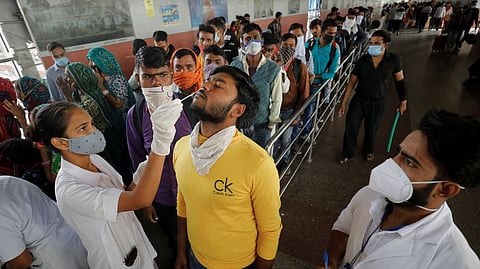

Reports of a steady spread of COVID-19 cases across pockets of India are now emerging. On Monday, India recorded as many as 1,800 new cases, twice the number recorded a week back. It is the third spike since the Omicron wave last year. The number of districts with a weekly test positivity rate (TPR) of 10% or more has increased to 32, across 14 States, and Union Territories. It is a three and a half fold rise since the past two weeks. A fortnight ago, nine districts across five States had reported a TPR of 10%, which is regarded as a marker of a high caseload.
As many as 63 districts in 19 States/UTs reported a TPR of 5-10% between March 19-25, an increase from 15 districts across eight States, two weeks ago. While hospitalisations remained low, doctors said patients were exhibiting symptoms similar to those seen during the third wave of the pandemic in India, between January and March 2022. Fresh cases in Tamil Nadu breached the 100 mark on Monday, as the public health department reported 102 new cases. This brought the active caseload in the State to 634. It was on November 8, 2022 when Tamil Nadu had reported 100 new cases.
The increase in caseload is no reason to panic as doctors say the situation must be monitored closely. However, there are a few data points worth considering. One of the areas of concern is the speedy administration of booster doses made available to citizens last January. Although the US Centers for Disease Control and Prevention had suggested people should be up to date on their vaccines, here in India, just about 16% of the population has been inoculated with the booster shot.
In the first year after the first dose was initiated in India, as much as 70% of the country’s population was partially vaccinated. A year after the second dose was introduced, 60% of India was fully vaccinated. However, more than a year after the introduction of the third booster shot, the coverage hovers around 16%, which is in line with the global response to the booster shot. Booster coverage in the Philippines was 18.8%, while Russia had 14.1% coverage and South Africa had 7.2% coverage. However, Nepal has outshone India with a 30% coverage, and so has Bangladesh with 39.4% and Brazil with 58.7% coverage.
Vaccine hesitancy has little to do with the lacklustre booster coverage in India, as compared to nations like France, Russia and South Korea where an unwillingness to be inoculated had contributed to lower coverage. A certain sense of complacency had set in within populations, as lakhs had been infected by the Omicron variant after two doses of the vaccine, and were expected to have developed immunity. Even among healthcare workers, just about 70% of those eligible have taken the booster, while 78% frontline workers got the third shot.
The Centre has advised States to increase genomic surveillance for detection of new variants and look out for the emergence of clusters. Mock drills are also being planned in April to assess public and private hospital readiness, with regard to the breakout of emergencies. Having tackled COVID for over two years now, it makes sense to err on the side of caution and follow basic pandemic etiquette. Like they say, better safe than sorry.
Visit news.dtnext.in to explore our interactive epaper!
Download the DT Next app for more exciting features!
Click here for iOS
Click here for Android